|
|
Post by theropod on Feb 13, 2013 23:20:54 GMT 5
Data on size, anatomy, physiology, behaviour etc. as long as it is about giant theropods. Lets define giant theropods, for the sake of this topic as theropods that were among the largest for their respective time and/or well-sampled habitat, or otherwise theropods at least at some point considered to be 3t or more in mass (even if you post to debunk that they are actually that large, this should be relevant insofar as that it concernes the validity of a potential giant theropod). Since this thread is now becoming very long, I’m compiling a short list of links to my more relevant posts below: hip height of giant theropods→why femur circumference is a bad predictor of mass→huge theropod ichnotaxa→density and weight in T. rex and Giganotosaurus→the relative sizes of holotype and neotype of Carcharodontosaurus saharicus→Siats meekerorum's size →Spinosaurus’ size→If someone else wants me to link any of their posts here, just let me know!If anyone else would like any of their posts linked in a similar manner, don’t hesitate to contact me. What I wouldn’t want to do is judge which posts deserve a link here and which don’t, so the best solution if you want to is to just decide for yourselves. My original intro: Theropod skull comparisonTheropod postcrania are often fragmentary and/or difficult to reconstruct, measure and find detailed documentation on. Luckily their crania are often easier to restore (which doesn't mean all skull reconstructions are accurate, mind you). They are also very prominent parts of the animal, the primary means of predation and could get very big proportionately, which means comparing skulls is helpful for getting an overall impression of their size and some of their most striking features. 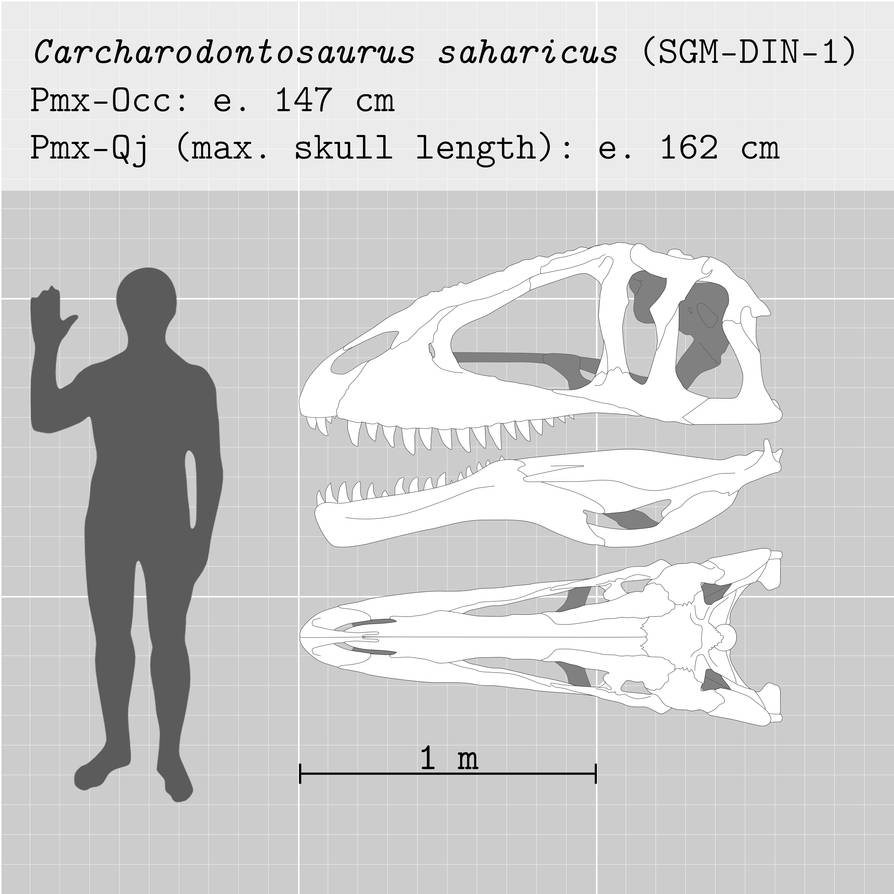 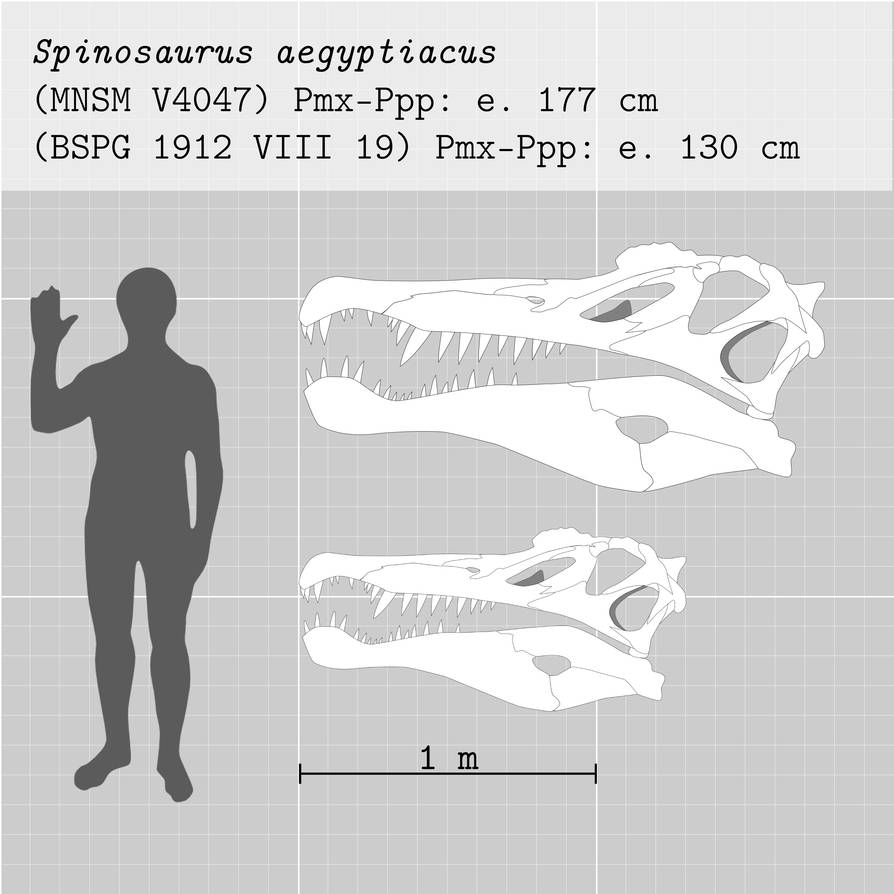 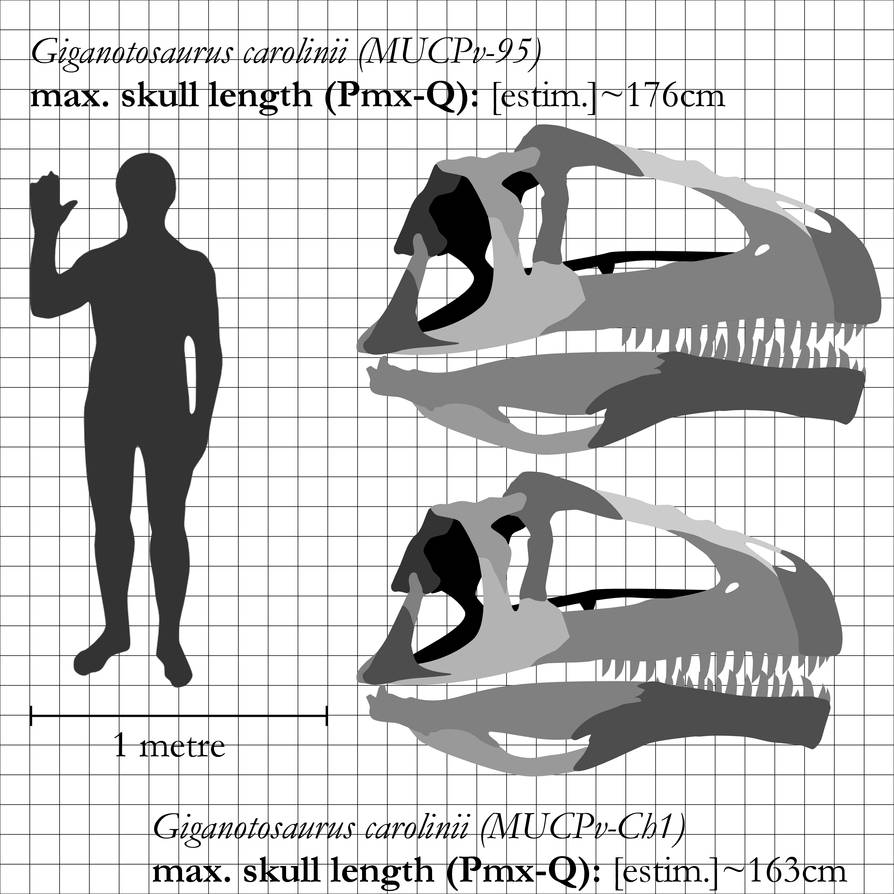 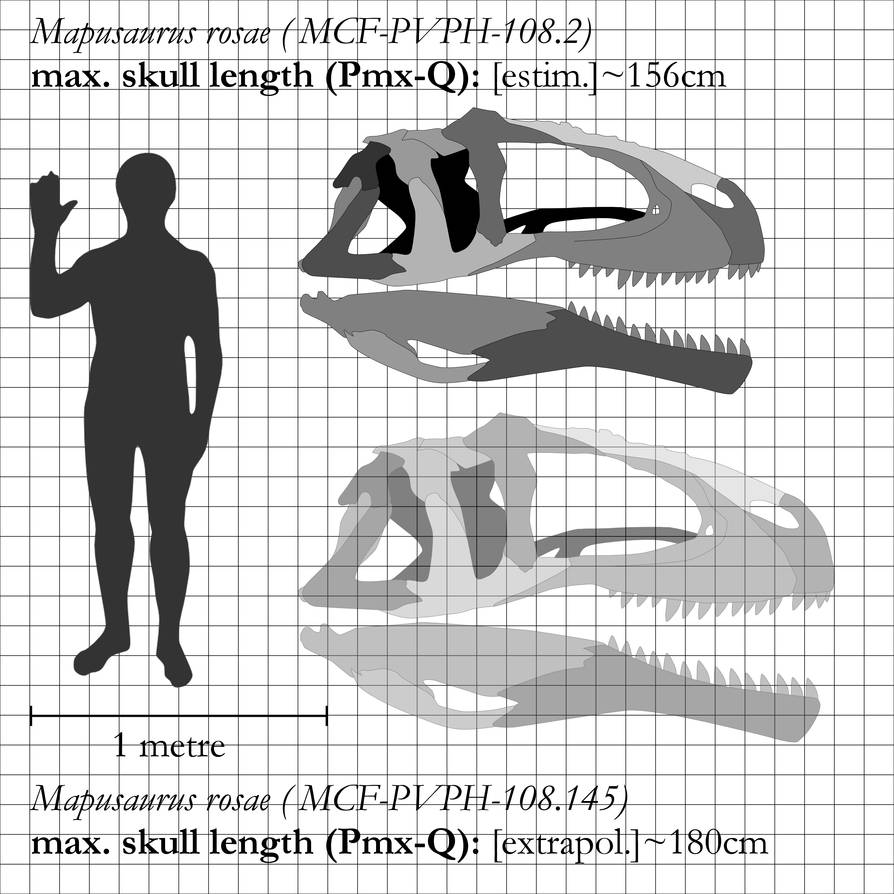 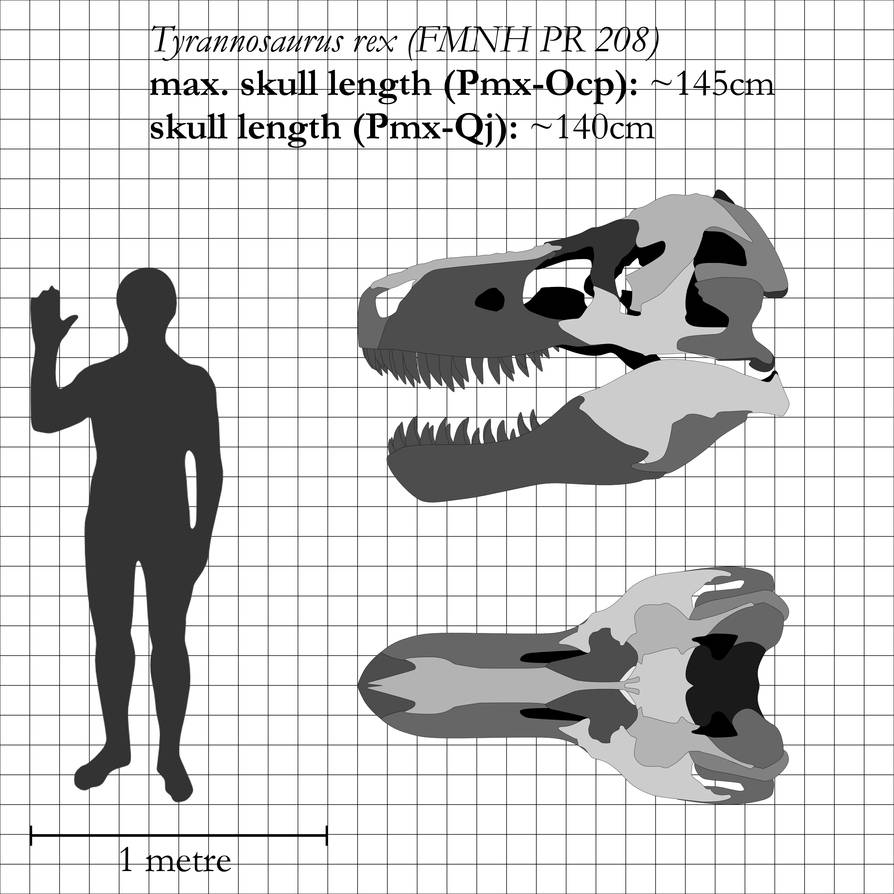
Papers on the currently largest known theropod footprints, barring the popular article mentioning an alledged 125cm "abelisaurid" footprint, which, if valid, is likely actually a giant carcharodontosaur or a taphonomic artefact of a smaller ichnite: Rauhut, O. W. M., L. Piñuela, D. Castanera, J.-C. García-Ramos, and I. Sánchez Cela. 2018: The largest European theropod dinosaurs: remains of a gigantic megalosaurid and giant theropod tracks from the Kimmeridgian of Asturias, Spain. PeerJ 6:e4963.
Boutakiout, M., M. Hadri, J. Nouri, I. Diaz-Martinez, and F. Perez-Lorente. 2009: Rastrilladas de icnitas terópodas gigantes del Jurásico Superior (Sinclinal de Iouaridène, Marruecos). Revista Espanola de Paleontologia 24. www.academia.edu/1209417/Rastrilladas_de_icnitas_teropodas_gigantes_del_Jurasico_Superior_Sinclinal_de_Iouaridene_Marruecos_Attachments:alloskull2.ods (17.24 KB)
|
|
|
|
Post by Grey on Feb 13, 2013 23:48:20 GMT 5
Yes, always post the original source.
Talking about updates, regarding Spinosaurus I would suggest to use primarily the 1,75 m skull length by Dal Sasso, possibly the 1,5 m reconstruction suggested by Cau. And bye bye to the suggestions of 1,95 m from the other forum.
The back of the skull seems too narrow even for a spinosaurid. The mandible sounds too massive, almost in the fashion of the Godzilla-creature of the 1998 movie.
The maximum width of Tyrannosaurus skull is a bit underestimated, you should add just one square (total width approx. 90 cm).
For the rest, I'll lookinf further later.
In any case, nice addition.
|
|
|
|
Post by theropod on Feb 14, 2013 0:19:43 GMT 5
Is the 90cm from the Brochu osteology? Keep in mind that skull was crushed. Reconstructing it in dorsal view was a real pain, and it is probably not 100% accurate, but it gives a good idea of the shape.
The back of the skull of spino is speculation, there is nothing conclusive on it. I will do an alternate version some day, but nothing to date proves or disproves it.
The dentary might be just a tad too long (spino possibly had an underbite), but still the mandible was incredibly massive for its skull size and rostral depth, and My restorations closely resembles those done by scientists that you will be able to find. It bases on Cristatusaurus' and Irritators respective mandibular proportions.
The tremendously massive mandible makes sense for an animal using its mouth to lift heavy fish. The load on the mandible would be far higher than the load on the rostrum.
|
|
|
|
Post by Life on Feb 14, 2013 0:28:48 GMT 5
Excellent work. Some other gigantic theropods were: 1. Mapusaurus roseae2. Acrocanthosaurus atokensisApart from these well-known ones, their is possibility of existence of other gigantic theropods in history which have not yet been discovered/identified due to poorly preserved fossil remains or fossil preservation bias in general. One such example provided here. |
|
|
|
Post by theropod on Feb 14, 2013 1:33:48 GMT 5
Thanks for the kind words! I'm working on getting a skull reconstruction of Mapusaurus done, but it will be pretty difficult, due to the abundance of different-sized specimens. I have already done one, but it's probably inaccurate:Done:  The shape of the squamosal seems unlikely now that I look at it again, but I might be able to utilise some of it foor a new recosntruction. Also, luckily, now that I have done giganotosaurus I have something to go by.Acrocanthosaurus is very well documented and I see no need to make a skull reconstruction of it, also, there are others freely available (PLOS content is CC-BY). See for example this article: www.plosone.org/article/info:doi/10.1371/journal.pone.0017932I used their skull to reconstruct my Giganotosaurus. The ichnogenus from the paper you posted seems to have been from the same time and place as the one I included as a speculative behemoth-Allosaurus in one of my skull diagrams (the one with the 90cm footprint). Thanks a lot for the article, its very interesting to read! |
|
|
|
Post by creature386 on Feb 14, 2013 2:03:09 GMT 5
I'll maybe make a table with the published lengths, skull lengths, locations and weights of gigantic theropods. Carrano defined theropods who weigh at least 1t as gigantic (and which have a femur length > 1100 mm). I will not list them all, just the most important and of course with source. Anyway, I have papers who review the body size evolution in dinosaurs (not only theropods, but I still think you will learn some stuff there about them, theropods seem to have the most complex patterns in size evolution) and there are some nice tables where I recomment looking at, to see body size evolution: Hone, D. W. E., Keesey, T. M., Pisani, D. & Purvis, A. 2005. Macroevolutionary trends in the Dinosauria: Cope’s Rule. Journal of Evolutionary Biology, 18, 587–595. online textCarrano, M. T. 2006. Body-size evolution in the Dinosauria. Pp. 225–268 in M. T. Carrano, T. J. Gaudin, R. W. Blob & J. R. Wible (eds) Amniote Paleobiology: Perspectives on the Evolution of Mammals, Birds, and Reptiles. University of Chicago Press, Chicago. download pdfThis could be a bit irrelevant for this topic (it could be a bit too general), but I think it is also nice to know, where (in which groups) you find the largest theropods. |
|
|
|
Post by Life on Feb 14, 2013 2:20:26 GMT 5
theropodTake your time. I fully understand that creative works requires time and effort. I am glad that I could offer you a useful paper. creature386That would be great effort.
|
|
|
|
Post by Grey on Feb 14, 2013 6:28:13 GMT 5
thanks! Is 90cm from the Brochu osteology? keep in mind that skull was crushed. Reconstructing it in dorsal view was a real pain, and it is probably not 100% accurate, but it gives a good idea of the shape. The back of the skull of spino is speculation, there is nothing conclusive on it. i will do an alternate version, but nothing to date proves or disproves it. The dentary might be just a tad too long (spino possibly had an underbite), but still the mandible was incredibly massive for its skull size and rostral depth. It bases on suchomimus and Irritators respective mandibular proportions. Regarding T. rex skull width I've got this from the McHenry thesis where he compares Tyrannosaurus and Kronosaurus skulls. Tyrannosaurus rex
BSL : 149.66 cm
DCL : 151.37 cm
CW : 89.21 cm
Skull vol : 158,061.0 cm cubeI don't know the original reference. Yes, this part of Spinosaurus is also very speculative, but I've not seen models or reconstructions depicting such a narrow back skull, it looks Suchomimus-like. Indeed, Spino's mandible is already very massive and striking when you look at the original reconstruction of Dal Sasso, that's why in the model it looks too much thick. Why don't you use the original reconstitution of 2005 as model ? |
|
|
|
Post by elosha11 on Feb 14, 2013 22:16:35 GMT 5
Hey, great start to this thread. I'm nowhere near the dino expert as most of you, but it's great reading and very informative.
|
|
|
|
Post by theropod on Feb 14, 2013 23:00:00 GMT 5
@elosha: Hi, nice to see you! Grey: Have there even been dorsal-view skull recosntructions by experts? I myself couldn't find any, not even amateurish ones. concerning these: Tyrannosaurus rex FMNH PR2081 T.r 149.66 151.37 89.21 158,061.0 5,654.0 I would really be highly interested in the original estimate, because the lenght figures are very different from those Brochu reported (but close to the presumed 153cm Holtz once stated in The Dinosauria, the figure of which noone knows how it can be in agreement with Brochu's) it might be from www.ingentaconnect.com/content/tandf/ghbi/2003/00000016/00000001/art00001which was given as a reference. The question is, which "version" of sues skull does it refer to? Being dorsoventrally compressed the original skull is likely somewhat broader than the skull was in life. It definitely isn't from "Cranial mechanics and feeding in Tyrannosaurus rex", which only mentions sue once. Snively et al., 2007 state sue's skull to be 1,4m up to the back of the opistothics (longest dimension of skull). As you see, not even the skull-lenght is really clear, even in such a nicely preserved, complete, popular specimen of the most popular dinosaur ever. I know the following figures: 153cm condylobasal lenght 138-141cm Pmx-qj (>which would make the largest dimension of the skull, pmx-sq about 146cm long) 151cm dorsal lenght (no idea what exact dimension this is), >149cm basal skull lenght (which I presume is the same as condylobasal lenght) 140cm maximum lenghtwhat confuses me is that actually the skull ought to have been more elongated due to the crushing. So I think the others which are not original measurements may have over or underestimated the overall skull dimensions, and I will definitely go with Brochu's figures that were originally measured; the width ought to get 10cm lower easily when decrushing the skull, but this somewhat depends on how you restore it. What this tells me is that there is more than one reconstruction of sue's skull, more than one way to dewarp it. I'd honestly be surprised if my dorsal view reconstruction in this case was reasonably accurate, at best it is an aproximation, as I had to rely on the crushed skull in Brochus paper. I had the picture lying underneath in inkscape all the time, so I know how the respective widths compare (Bruchu gives the width at the infratemporal fenestrae as 94cm, now it depends on how much taller you make the decompressed skull): here is the table from brochu, 2003: ----------------------- width between infratemporal fenestrae 94.5 width between top of orbits 53.5 width of snout anterior to antorbital fenestra 38.3 width of nasals over antorbital fenestra 12.3 width of premaxillary anterior ascending process 3.0 tip of premaxilla to frontoparietal suture 105.8 frontoparietal suture to occipital condyle 30.0 length, tip of snout to back of left quadratojugal 140.7 length, tip of snout to back of right quadratojugal 138.0 dorsoventral depth, postorbital to ventralmost extent of jugal dorsoventral depth, top of supraoccipital to bottom of basioccipital 47.7 45.1 dorsoventral depth, snout at break in front of orbits 34.3 -------------------- All measurements in cm and referring to the crushed skull. The maximum skull width was probably somewhere between 80 and 90cm, the maximum lenght somewhere between 145cm and 153cm. Depending on the depth, the width will in every case be lower than 94cm, how much depends on the dewarping but it cannot get both deeper, longer and wider at once, so I presume some miscitations could be involved. |
|
|
|
Post by theropod on Feb 16, 2013 0:48:01 GMT 5
![]() outdated image, see the above posts for the new one[/img] I added the skull of Mapusaurus, based on acrocanthosaurus, the individual crosscaled bones from Coria & Currie, 2006, and the quadrate size is based on Giganotosaurus. It seems noticeably smaller, but it is nearly the same lenght, and the skull isn't the largest specimen, just an 11,2cm deep dentary. overall, contrary to what I used to think, it ended up less robust than Giganotosaurus and Carcharodontosaurus. In this regard I was totally misinformed. I used to think Mapusaurus had the deepest skull of any carcharodontosaur, followed by carcharodontosaurus, and Giganotosaurus was the most elongate. It turned out that the reverse is the case... However it's the same as with sue, it might be possible to reconstruct it differently (in sues case dewarp it), yielding a different shape. this one is fairly similar to a cast an image of which I once posted in Grey's "biggest predator jaws thread" on carnivora, which I unfortunately cannot find any more. What do you think? |
|
|
|
Post by theropod on Feb 16, 2013 17:06:24 GMT 5
I think I'll do Torvosaurus/Edmarka and try to estimate its size based on the largest remains (there is a 44cm Edmarka jugal, and a scapula that measures 95cm but isn't complete, and hip material I heard of), that is, if member Blaze doesn't before me.
The ones of you who have read the respective topics on carnivora ought to know determinging the maximum skull size and total size in this taxon is problematic.
Then I think I'm done with the skull reconstructions and I'll mostly do updates. Up to now this thread was pretty focused on the skull sizes, that's because I think they can often give a reasonably good, tough not necessarily accurate, impression of their absolute sizes and the capacity of their bites, thus also their ecology and so on.
|
|
|
|
Post by theropod on Feb 16, 2013 17:49:47 GMT 5
Does anyone have a photgraph or drawing of the holotypic remains of Edmarka rex?
|
|
|
|
Post by creature386 on Feb 16, 2013 18:55:03 GMT 5
|
|
|
|
Post by theropod on Feb 16, 2013 21:34:25 GMT 5
I think they are synonymous anyway, but it would be good to have a photograph of Edmarkas jugal nevertheless, after all the known one is not complete. I have actually already finished my torvosaurus (that is, two versions of it, because it is possible to restore torvosaurus at completely different stages of skull robusticity while basing on the same remains. I made one based on dubreuillosaurus and one based on afrovenator, and that pretty much reflects the differences between the various casts and published reconstructions), but I feel it is not ready for publication yet, I'd like to see whether I can get more material to make it more reliable. btw I found the image that resembles my Mapusaurus skull in shape, even tough it seems to be bigger: blog.rom.on.ca/wp-content/uploads/2012/10/DSC_8280.jpgEDIT: I measured the image and WOW; going by the proportions measured in gimp it would be 182cm at a minimum dentary depth of 11,2cm (325px long, dentary is 20px deep, ratio=16,25; 16,25*11,2=182cm!) Perspective might play a bit of a role here, but I'm really surprised that there is such a huge difference here, one wouldn't think that just from viewing the images. PS: why don't my images show up if I use ![]() -tags? |
|

















